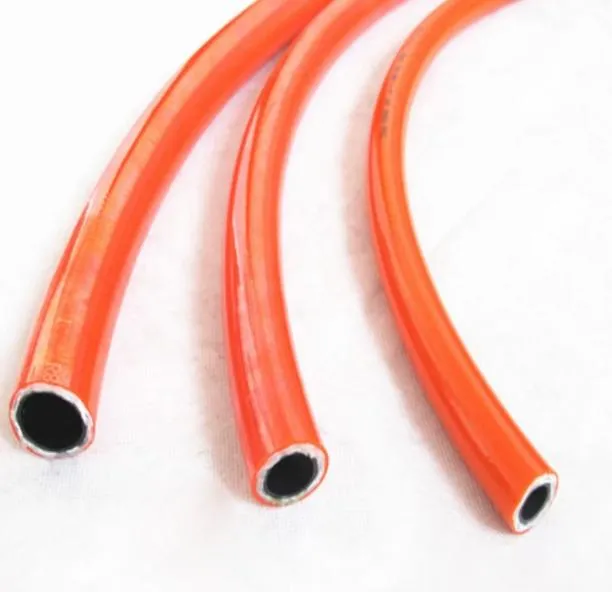Jul . 02, 2025 11:41 Back to list
The Versatility and Efficiency of Thermoplastic Hydraulic Hoses
Understanding the Role of Thermoplastic Hydraulic Hoses
Thermoplastic hoses have become increasingly popular in hydraulic systems thanks to their lightweight design, flexible construction, and impressive performance across various applications. A thermoplastic hydraulic hose is typically made from multiple layers of polymer-based materials, often reinforced with high-strength fibers. This multi-layer construction provides high pressure resistance, excellent chemical compatibility, and superior flexibility, making it a preferred solution in industries such as agriculture, construction, logistics, and material handling.
Unlike traditional rubber hoses, thermoplastic hose options offer a cleaner and more controlled manufacturing process. They are also non-conductive and resistant to external abrasion, moisture, and UV rays. Because of these properties, thermoplastic hoses are widely used in situations where safety, precision, and durability are paramount.

Key Benefits of Thermoplastic Hose Technology
One of the most significant advantages of thermoplastic hydraulic hose systems is their high pressure capacity despite their lightweight build. These hoses are designed to handle demanding environments while remaining easy to route through compact spaces. This is especially important in modern hydraulic machinery, where space-saving and efficiency are critical.
Additionally, thermoplastic hoses maintain their performance in extreme temperatures, typically ranging from -40°C to 100°C. Their resistance to swelling and deformation under pressure ensures a long service life and consistent reliability. Moreover, the smooth inner tube enhances fluid flow while minimizing friction loss, resulting in better system efficiency.
Exploring the Differences: 100R7 vs 100R8 Thermoplastic Hose
Two of the most widely used types of thermoplastic hoses are the 100r7 thermoplastic hose and the 100r8 thermoplastic hose, each engineered to meet specific performance requirements.
100R7 thermoplastic hose typically features a nylon inner tube, synthetic fiber reinforcement, and a thermoplastic outer cover. It is designed for medium-pressure applications and is compatible with hydraulic fluids such as synthetic esters, water-glycols, and petroleum-based oils. This hose type is commonly used in lift equipment, agricultural machinery, and general industrial hydraulic systems.
In contrast, the 100r8 thermoplastic hose is built for high-pressure applications. It also includes a nylon core and a thermoplastic shell but is reinforced with two braids of synthetic fiber. This additional reinforcement allows it to withstand higher working pressures, making it ideal for heavy-duty operations such as boom trucks, forklifts, and construction machinery.
Design Innovations and Customization Options
The design versatility of thermoplastic hose assemblies allows manufacturers to meet the diverse requirements of modern hydraulic systems. They can be configured with various fittings, protective sleeves, and customized lengths to suit specific applications.
Some hoses come with features like micro-perforated covers for pneumatic applications or conductive tubes for electrical discharge environments. These design options enable users to optimize their hydraulic systems for better safety and performance. Moreover, thermoplastic hoses are compatible with a range of coupling technologies, offering leak-proof sealing and easy installation.
Manufacturers also offer color-coded hose covers to simplify identification and maintenance. This feature is particularly useful in complex hydraulic systems where multiple hoses run in parallel, reducing the risk of errors during servicing or repairs.
Applications Across Industries
The demand for thermoplastic hydraulic hose solutions spans a wide range of industries. In the agricultural sector, they are favored for their resistance to fertilizers, harsh weather, and constant mechanical movement. Construction and mining operations benefit from their ability to handle heavy loads and vibrations while withstanding contaminants such as oil and debris.
In material handling and warehousing, thermoplastic hoses are used in equipment such as pallet jacks, scissor lifts, and automated storage systems. Their flexible and compact nature makes them ideal for tight spaces and moving joints.
Moreover, in offshore and marine industries, the non-corrosive and non-conductive nature of thermoplastic hoses makes them suitable for use in environments with high salt content and risk of electrical interference.
Thermoplastic hydraulic hose FAQs
What makes thermoplastic hydraulic hose different from rubber hose?
Thermoplastic hydraulic hoses offer greater chemical resistance, lower weight, and better performance in cold environments compared to rubber hoses. They are also more flexible and often have longer service lives under extreme conditions.
Which industries typically use 100r7 thermoplastic hose?
The 100r7 thermoplastic hose is commonly used in agriculture, material handling, and industrial automation due to its medium-pressure rating and compatibility with multiple hydraulic fluids.
What are the advantages of using 100r8 thermoplastic hose in construction equipment?
The 100r8 thermoplastic hose offers higher pressure capacity and reinforced durability, making it ideal for high-stress applications like boom lifts, cranes, and heavy-duty hydraulic circuits.
Can thermoplastic hose assemblies be customized?
Yes, thermoplastic hydraulic hose assemblies can be customized in terms of length, fitting type, cover color, and added protection layers to meet specific system requirements.
Are thermoplastic hoses suitable for high-temperature applications?
Most thermoplastic hose products can operate in a temperature range of -40°C to 100°C, with specialized versions available for higher temperature environments depending on the material and construction.
-
Thermoplastic Hose Chemical Resistance Fluid Compatibility
NewsJul.14,2025
-
Steel Wire Braid Hydraulic Hose Factory Production Process
NewsJul.14,2025
-
SAE Hydraulic Hose Specs Textile Reinforcement Layer Structure
NewsJul.14,2025
-
High Pressure Hydraulic Hose Factory CNC Bending Process
NewsJul.14,2025
-
China Wire Spiral Hydraulic Hose High Temperature Resistance
NewsJul.14,2025
-
Automotive Air Conditioning Hose Ozone Resistance Testing
NewsJul.14,2025
